The Intel Core i9-7980XE and Core i9-7960X CPU Review Part 1: Workstation
by Ian Cutress on September 25, 2017 3:01 AM ESTBenchmarking Performance: CPU Legacy Tests
Our legacy tests represent benchmarks that were once at the height of their time. Some of these are industry standard synthetics, and we have data going back over 10 years. All of the data here has been rerun on Windows 10, and we plan to go back several generations of components to see how performance has evolved.
All of our benchmark results can also be found in our benchmark engine, Bench.
3D Particle Movement v1
3DPM is a self-penned benchmark, taking basic 3D movement algorithms used in Brownian Motion simulations and testing them for speed. High floating point performance, MHz and IPC wins in the single thread version, whereas the multithread version has to handle the threads and loves more cores. This is the original version, written in the style of a typical non-computer science student coding up an algorithm for their theoretical problem, and comes without any non-obvious optimizations not already performed by the compiler, such as false sharing.


CineBench 11.5 and 10
Cinebench is a widely known benchmarking tool for measuring performance relative to MAXON's animation software Cinema 4D. Cinebench has been optimized over a decade and focuses on purely CPU horsepower, meaning if there is a discrepancy in pure throughput characteristics, Cinebench is likely to show that discrepancy. Arguably other software doesn't make use of all the tools available, so the real world relevance might purely be academic, but given our large database of data for Cinebench it seems difficult to ignore a small five minute test. We run the modern version 15 in this test, as well as the older 11.5 and 10 due to our back data.
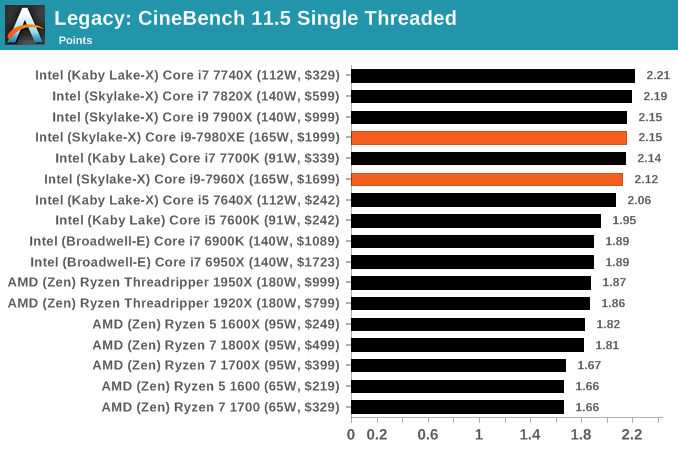
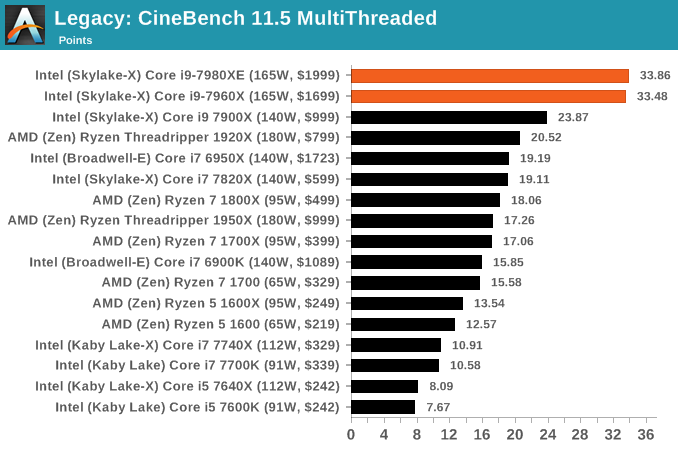
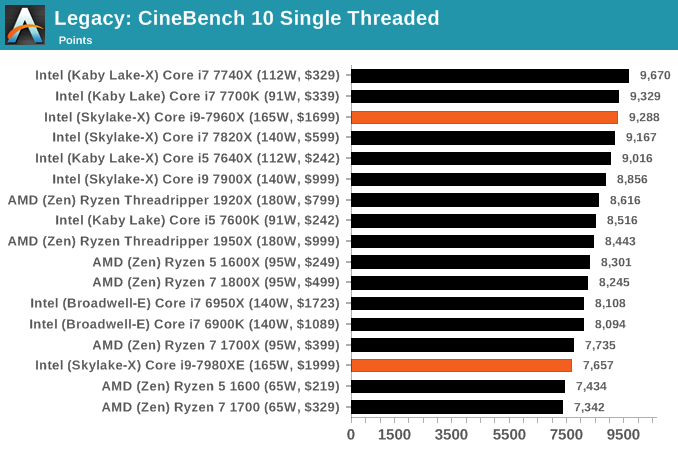
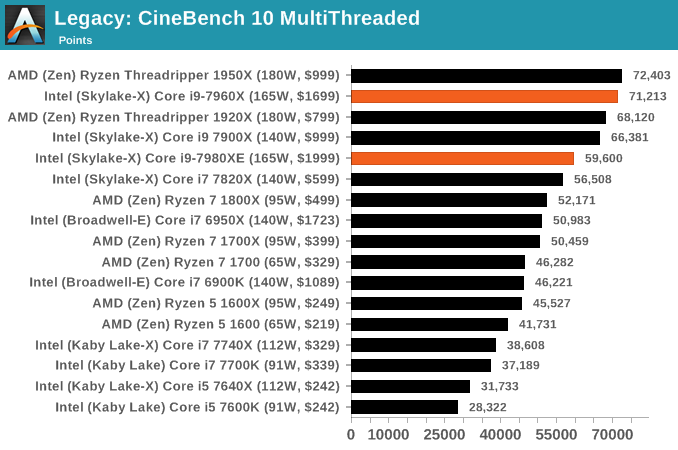
x264 HD 3.0
Similarly, the x264 HD 3.0 package we use here is also kept for historic regressional data. The latest version is 5.0.1, and encodes a 1080p video clip into a high quality x264 file. Version 3.0 only performs the same test on a 720p file, and in most circumstances the software performance hits its limit on high end processors, but still works well for mainstream and low-end. Also, this version only takes a few minutes, whereas the latest can take over 90 minutes to run.
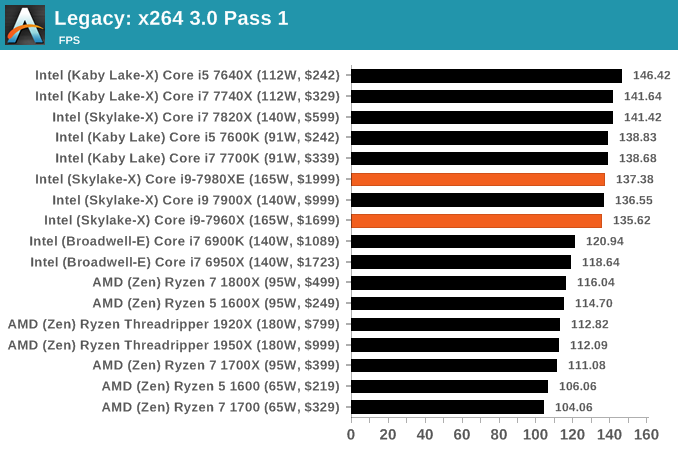
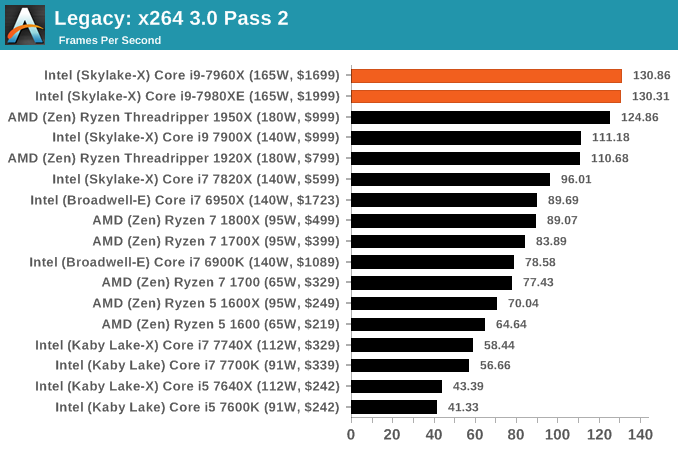










152 Comments
View All Comments
extide - Monday, September 25, 2017 - link
No, TDP should include Turbo as that is part of the base/stock operation mode of the CPU.IGTrading - Monday, September 25, 2017 - link
TDP = Total Design Power by definition.This is used to design the motherboard and the cooling system to give designers a clear limit over which the system doesn't go unless it is purposely overcloked.
Wikipedia : "The thermal design power (TDP), sometimes called thermal design point, is the maximum amount of heat generated by a computer chip or component (often the CPU or GPU) that the cooling system in a computer is designed to dissipate under any workload."
Intel : "TDP (Thermal Design Power) Intel defines TDP as follows: The upper point of the thermal profile consists of the Thermal Design
Power (TDP) and the associated Tcase value. Thermal Design Power (TDP) should be used for
processor thermal solution design targets. TDP is not the maximum power that the processor can
dissipate. TDP is measured at maximum TCASE.1"
Intel : "Due to normal manufacturing variations, the exact thermal characteristics of each individual processor are unique. Within the specified parameters of the part, some processors may operate at a slightly higher or lower voltage, some may dissipate slightly higher or lower power and some may draw slightly higher or lower current. As such, no two parts have identical power and thermal characteristics.
However the TDP specifications represent a “will not exceed” value. "
This is what we've understood by TDP in the past 21 years while in IT hardware industry.
If you have a different definition, then perhaps we're talking about different things.
whatevs - Monday, September 25, 2017 - link
Specification for 7980xe says "Thermal Design Power (TDP) represents the average power, in watts, the processor dissipates when operating at Base Frequency with all cores active under an Intel-defined, high-complexity workload. Refer to Datasheet for thermal solution requirements."There's a different specification for electrical design. This is not your ancient Xeon TDP.
IGTrading - Monday, September 25, 2017 - link
You mean the definition of TDP should change every year to suit Intel's marketing ?! :)"Ancient" Xeon TDP ?! :)
I've quoted Intel's own definition.
If the company just came up with a NEW and DIFFERENT definition just for the Core i9 series, then that's just plain deceiving marketing, changing with the wind (read : new generation of products) .
Plus, why the heck are they calling it TDP ?!
If they now claim that TDP "represents the average power, in watts, the processor dissipates when operating at Base Frequency with all cores active " then they basically use AMD's ACP from 2011.
What a load of nonsense from Intel ...
https://www.intel.com/content/dam/doc/white-paper/...
whatevs - Monday, September 25, 2017 - link
You have quoted 6 year old Xeon definition, different products have different operating conditions, deal with it.Spunjji - Monday, September 25, 2017 - link
Your name suggests that you're kind of a dick and your comments confirm it. Your point is weak and doesn't at all do the work you think it does.whatevs - Monday, September 25, 2017 - link
You may be unhappy with what Intel promised you, but to claim that you could burn a system with increased power usage from turbo clocks is ridiculous, thermal throttling is not fire, and it's ridiculous to argue on a cpu that can run overclocked at >400w power consumption.Notmyusualid - Monday, September 25, 2017 - link
+1wolfemane - Tuesday, September 26, 2017 - link
You can't talk rationale with a loyalist sympathizer. TDP is a set definition in the industry and one Intel seems to be misleading about with their Extreme HEDT CPU. That seems to be a fact clearly made among almost all reviews of the 7980xe.I think I read a few articles yesterday talking about how the 7980xe was having major issues and wasn't boosting correctly but showing high power draw. But yesterday was a long time ago and I cant remember where I read that.
someonesomewherelse - Saturday, October 14, 2017 - link
So why not call it 'Average Design Power - ADP'?